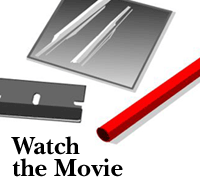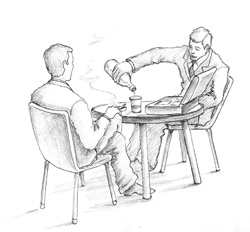ERP®: Addiction Therapy

Exposure Response Prevention Therapy (ERP®) exposes a user to their drug or alcohol triggers but prevents them from getting high. ERP® helps users to confront their worst fear: accidental exposure to substance abuse triggers. It prepares them to handle these situations without making them overconfident. After ERP® therapy they will not experience an unmanageable level of craving if they are triggered by a situation. Instead, the situation will trigger cognitive scripts that will help them to think and talk their way out of the situation without using. ERP® greatly increases the chances of maintaining a successfull recovery.
|
| Relaxation, Craving Rating, and Pulse
|
A typical ERP® session starts with about five minutes of relaxation exercises. After relaxing, the user is asked to rate their craving level before being exposed to their triggering stimuli. They use a 10 point scale to do this where 10 represents a desire to use immediately. The userąs pulse is also measured (pulse rate generally increases as a userąs craving level rises).
|
| First level of stimulus
|
Once baseline ratings are secured exposure to three levels of stimulation begins. For the first level of exposure the user looks at the objects and answers a few questions. The user is then asked to rate their craving level. Their pulse is taken again as well. Generally, their craving level is up as is their pulse. If they have become over stimulated then the ERP® stimuli are put away and they return to doing relaxation exercises. Otherwise, they continue to look at the objects while repeating their cognitive scripts.
|
| Cognitive scripts
|
Cognitive scripts are motivating statements designed by therapist and client. During ERP® therapy they
become associated with the triggering stimulus and the impulse to use.
Typical Cognitive Scripts
"Remember how this addiction has affected my work."
"I used to be so much more focused before I started using." |

|
|
| Respondent connection
|
The user makes a respondent connection between these scripts and stimuli formerly associated with chemical abuse. So not only does the user break the drink or drug connection with the triggering stimuli, he also connects the stimuli with his cognitive scripts. This new connection will help him to walk away from a tempting situation.
|
| Increasing levels of exposure
|
Once a user has completed the first level of stimulus exposure he proceeds to the next level and repeats all of the steps. An ERP® therapy session continues until the user has completed all of the stimulus exposure levels or the session has to be stopped because of over stimulation. The typical user requires at least 30 ERP® sessions to complete the entire stimulus hierarchy without experiencing any significant levels of craving (as measured by the rating scale and pulse rate). Once a user can view the ERP® stimuli without experiencing an impulse to use they can end this part of their treatment.
|





